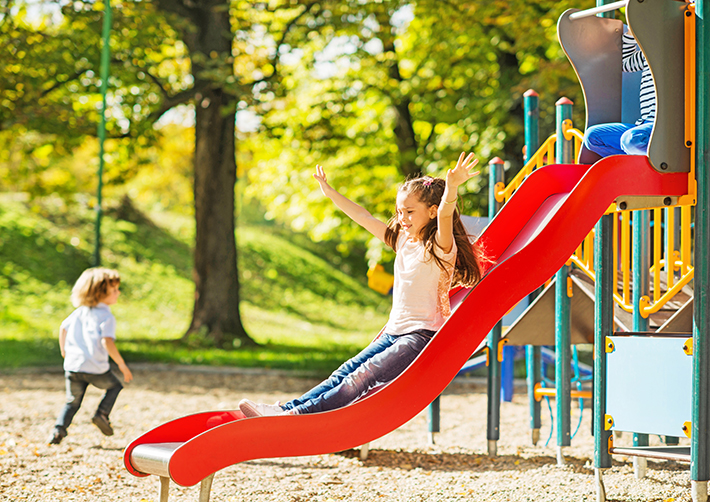
It's All About Play
Play is children’s work, and playgrounds give kids a place where they can learn and develop skills, coordination, cooperation, imagination, and more. And in the ever-evolving marketplace, these collections of equipment are being designed and developed to allow and encourage various activities, as well as to reflect a certain look.
Alongside this evolution, the consumer safety performance specification for playground equipment for public use (F1487) has supported children’s safety while at play for close to 30 years. A subcommittee in the consumer products committee (F15) oversees the F1487 playground standard (there’s a separate specification for backyard playground equipment) and takes the approach of furthering safety without limiting design.
“Instead of focusing strictly on design criteria, we look at the hazards associated with each type of equipment,” says Lloyd Reese, vice president of technical product management with PlayCore. Reese works on the responsible subcommittee on playground equipment for public use (F15.29) as well as the subcommittee on playground surfacing systems (F08.63), which oversees standards for the surfaces around playgrounds.
Now, a revision of the F1487 playground standard has been completed, and it references additional standards for these surrounding surfaces.
The Revision
The subcommittee on playground equipment for public use today numbers more than 250 stakeholders — manufacturers, playground organizations, labs, academia, government agencies, and many others. They completed the F1487 revision in the spring.
READ MORE: Safer Connected Consumer Products
Kenneth Kutska is executive director at the International Playground Safety Institute LLC and chair of F15.29. Of the new version of the standard, he says, “These revisions help clarify changes occurring internationally within the industry. Most significantly, this version addresses performance requirements related to new equipment types introduced in the marketplace that are not covered in the existing standard.”
Julie Boland adds, “All of these changes will help to provide today’s youth with accessible, safe, and challenging play environments.” An F15 member, Boland is vice president of credentialing and member operations at the National Recreation and Park Association (NRPA), a network of park and recreation professionals and advocates whose work includes a worldwide playground certification program.
Kutska notes that the F1487 changes begin at the very beginning of the standard: with the scope. “There was a basic change in the scope to clarify and alert the users of the standard that ‘clearance and use zone’ requirements related to the playground equipment and its relationship to the protective surfacing and three-dimensional space around the equipment is considered within the standard.”
One newly expanded section of the standard addresses both fixed and flexible track or trolley rides, which can have seats or a handlebar. The standard includes factors such as speed and potential impact hazards by addressing clearance and use zones throughout the path or travel of a suspended seat. “It took about three years to finally come to consensus, but I think we have a very powerful and needed text. Getting these new requirements in this revision was important because it had gotten to the point where we were seeing many different types of these in the field,” Reese says.
Kutska adds, “We also added a better explanation of what the manufacturer, designer, and/or owner needs to do to verify that the playground equipment and its protective surfacing use zones comply with the minimum performance requirements of this standard.” According to the standard, the verification shall be in writing by a qualified person and be kept as part of the owner’s documentation papers, which the standard already requires.
In allowing for designer/manufacturer innovation and appropriate documentation as already stated in the standard, a new appendix addresses this by detailing how a hazard identification and risk/benefit assessment process might be done. The appendix gives guidance and three examples about how one might go about completing this process along with information related to recommended maintenance practices for the functional life of the equipment and/or protective surfacing.

The revised playground standard takes into account many new elements.
New sections have been added that specifically address playground equipment installation and maintenance to clarify the responsibilities of all involved in these processes. The standard now says that installers need to indicate in writing, by a qualified person, that the work has been done according to the owner’s/manufacturer’s instructions, plans, and specifications.
Boland summarizes: “The F1487-21 standard revisions help to provide clarity and accuracy to terms, references, and responsibilities. These modifications are meant to ensure that the scope is inclusive of clearance and use zones for the safety of users; to reflect new findings related to equipment and safety; and to assist users with hazard identification and risk/benefit assessments through a new appendix.”
And More
The revised standard covers the equipment itself, and it references standards for the surfaces around a playground, which form an integral part of the entire system. Standards from the F08.63 subcommittee, part of the committee on sports equipment, playing surfaces, and facilities (F08) provide further guidance on this component.
Last year, the F08 committee completed various standards changes primarily related to F1292 for the performance requirements for playground protective surfacing. The committee also developed a new standard (F3313) for field testing protective surfacing for impact attenuation performance to surfaces installed around a playground, now referenced in F1487. The test method for determining impact attenuation of playground surfaces within the use zone of playground equipment as tested in the field (F3313) provides a uniform means to quantify how a surface responds to an impact from a falling object. That data guides the estimation of the relative risk of a head injury — in children 2 to 12 years — due to a fall. This test provides the ability to compare surface impact attenuation to the results of the three-temperature laboratory test found in the specification for impact attenuation of surfacing materials within the use zone of playground equipment (F1292).
Another significant standard (F3351) added to the family of playground-related standards is a specified fall height laboratory test. This impact test allows for reporting HIC (head injury criteria) and g-max at specified heights lower than the critical fall height. The critical fall height is the maximum fall height from which a life threatening head injury would not be expected to occur, which is still based on the maximum impact threshold of 200 g and 1000 HIC.
FOR YOU: Safety Is the Goal – Standards for Playing Surfaces
In practice, as Reese notes, “What we’ve found is that a lot of manufacturers don’t want to market surfaces that get close to critical fall height.” This standard provides a way for manufacturers to differentiate their products and indicate how their surfacing performs at heights less than the maximum allowed.
In total, the standards all support safer play.
Practically Speaking
A broad group of stakeholders uses the playground standard: playground equipment designers, landscape architects, architects, manufacturers, suppliers, planners, installers, providers, owner agencies, and maintenance technicians. And one more: inspectors.
Boland notes, “The ASTM F1487 standard is a critical component for our Certified Playground Safety Inspector and Playground Maintenance course, but most important, it is necessary for the safety of today’s youth who will be enjoying those very playgrounds.” That program offers training in hazard identification, equipment specifications, surfacing requirements, and risk management.
“NRPA uses this standard along with other standards and the CPSC [U.S. Consumer Product Safety Commission] Handbook to certify playground safety inspectors,” Kutska adds. “They have been doing this for over 25 years and have trained approaching 100,000 participants.” That includes inspectors all over Europe and Asia, as well as North America, who have been trained through the program.
Over the years, the F15.29 subcommittee has kept F1487’s practical use in mind as it has refined the standard. Reese says, “Because we have had the exposure to so many laypeople in using the standard, I think that we have continued to evolve it into a user-friendly document.”
A Final Note
“Standards such as these are necessary to ensure that children are able to safely develop their physical, intellectual, social, and emotional skills through play on playgrounds,” Boland says. “The revision of standards such as F1487 is necessary to ensure they remain relevant and current in the ever-changing world of playground equipment education, development, and innovation.”
The ASTM groups responsible for these standards continue to refine and revise them as new technologies and needs come up to help children play safely in a reasonably safe environment. In the end, it is all about keeping our children active and engaged in play.
All those interested in participating are welcome. As Kutska puts it, “Our door is always open to new, interested persons regardless of their background.” ■
 SN Home
SN Home Archive
Archive Advertisers
Advertisers Masthead
Masthead RateCard
RateCard Subscribe
Subscribe Email Editor
Email Editor